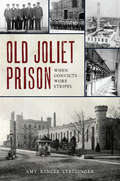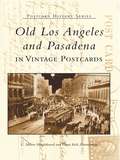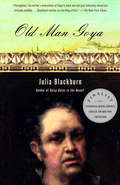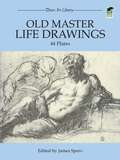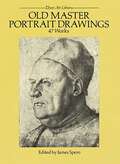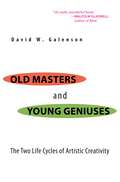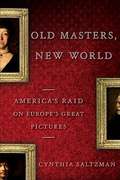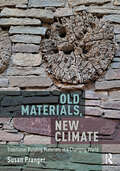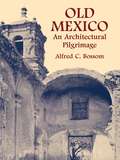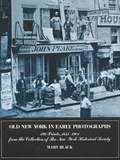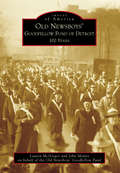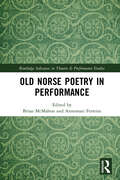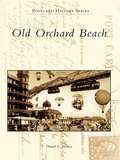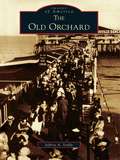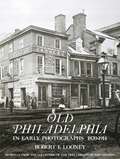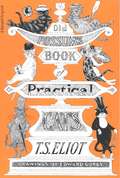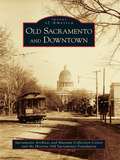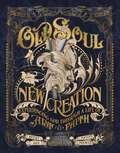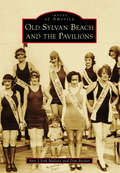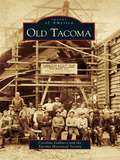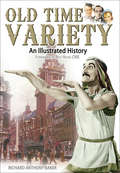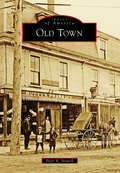- Table View
- List View
Old In Art School: A Memoir of Starting Over
by Nell PainterFollowing her retirement from Princeton University, celebrated historian Dr. Nell Irvin Painter surprised everyone in her life by returning to school--in her sixties--to earn a BFA and MFA in painting. In Old in Art School, she travels from her beloved Newark to the prestigious Rhode Island School of Design; finds meaning in the artists she loves, even as she comes to understand how they may be undervalued; and struggles with the unstable balance between the pursuit of art and the inevitable, sometimes painful demands of a life fully lived. How are women and artists seen and judged by their age, looks, and race? What does it mean when someone says, "You will never be an artist"? Who defines what "An Artist" is and all that goes with such an identity, and how are these ideas tied to our shared conceptions of beauty, value, and difference? Old in Art School is Nell Painter's ongoing exploration of those crucial questions. Bringing to bear incisive insights from two careers, Painter weaves a frank, funny, and often surprising tale of her move from academia to art.
Old Joliet Prison: When Convicts Wore Stripes (Landmarks)
by Amy Kinzer SteidingerIn 1857, convicts began breaking rock to build the walls of the Illinois State penitentiary at Joliet, the prison that would later confine them. For a century and a half, thousands of men and women were sentenced to do time in this historic, castle-like fortress on Collins Street. Its bakery fed victims of the Great Chicago Fire, and its locks frustrated pickpockets from the world's fair. Even newspaper-selling sensations like the Lambeth Poisoner, the Haymarket Anarchists, the Marcus Train Robbers and Fainting Bertha became numbers once they passed through the gates. Author Amy Steidinger recovers stories of lunatics and lawmen, counterfeiters and call girls, grave robbers and politicians.
Old Los Angeles and Pasadena in Vintage Postcards
by Elena Irish Zimmerman C. Milton HinshilwoodCovering the history and geography of Los Angeles and Pasadena between 1900 and 1950, the collection of over 200 vintage postcards compiled in this new volume offers a unique glimpse into turn-of-the-century southern California. As communication by postcards became popular in the late 19th century, those who received them were offered a rare view of the "right here, right now" aspect that only postcard photography could offer. From the earliest images of the Angels' Flight in Los Angeles, to the Tournament of Roses parades gliding down Colorado Street, the authors celebrate the history of these two beautiful cities through the personal medium of vintage postcards.
Old Man Goya
by Julia BlackburnIn 1792, when he was forty-seven, the Spanish painter Francisco de Goya contracted a serious illness that left him stone deaf. In this extraordinary book, Julia Blackburn follows Goya through the remaining thirty-five years of his life. It was a time of political turmoil, of war, violence, and confusion, and Goya transformed what he saw around him into visionary paintings, drawings, and etchings. These were also years of tenderness for Goya, of intimate relationships with the Duchess of Alba and with Leocadia, his mistress, who accompanied him to the end. Blackburn's singular distinction as a biographer is her uncanny ability to create a kaleidoscope of biography, memoir, history, and meditation--to think herself into another world. In Goya she has found the perfect subject. Visiting the towns Goya frequented, reading the revelatory letters that he wrote for years to a boyhood friend, investigating the subjects he portrayed, Julia Blackburn writes about the elderly painter with the intimacy of an old friend, seeing through his eyes and sharing the silence in his head.With unprecedented immediacy and illumination, Old Man Goya gives us an unparalleled portrait of the artist.
Old Master Life Drawings: 44 Plates
by James SperoFrom earliest days, artists have sought to record the beauty, form, movement, and infinite variety of the human body. Among the most successful were the great masters of the various European traditions and schools of art. The extraordinary skill, inspiration, and technique they brought to figure drawing resulted in many masterpieces.This anthology, carefully reproduced from rare portfolios, presents over forty of those works, by artists ranging from the 15th century Italian Filippino Lippi to the 19th century French classicist, J. A. D. Ingres. Included are such highlights as a Michelangelo study for a dead Christ; two drawings of seated women by Rembrandt; a study by Rubens for Daniel in the Lions' Den, and splendid nudes by Tintoretto, Titian, Andrea del Sarto, Raphael, Pontormo, and other celebrated artists. The drawings included in this volume reveal differences in attitudes toward the nude figure and in artistic technique. Some masters, such as Tintoretto, use an agitated, almost calligraphic line, while others, such as Michelangelo, create the illusion of a smooth, undulating surface. The drawings are lessons in foreshortening, and in how to handle various media -- ink, chalk, pencil, and charcoal. These and many more artistic insights, embodied in drawings of striking beauty, are yours to study and enjoy in this collection, available nowhere else at this price.
Old Master Portrait Drawings: 47 Works
by James SperoHere are 47 masterpieces of the art of portrait drawing, selected from the work of an elite group of artists who represent the great schools and traditions of Italy and northern Europe from the 15th to the 19th centuries. Among the artists are Andrea Mantegna, Filippino Lippi, Raphael, Dürer, Andrea del Sarto, Titian, Pontormo, Lucas van Leyden, Holbein, Rubens, Hals, Bernini, Van Dyck, Rembrandt, Hyacinthe Rigaud, Watteau, and Ingres. In these striking, brilliantly realized portraits, art students will find a concise survey of the finest examples of portrait drawing -- works of art whose deeply impressive effects were attained through great individuality of focus, style, and technical achievement. Art enthusiasts will savor the choice, far-ranging content of this exemplary collection, which combines in one inexpensive volume master drawings by so many great artists.
Old Masters and Young Geniuses: The Two Life Cycles of Artistic Creativity
by David W. GalensonWhen in their lives do great artists produce their greatest art? Do they strive for creative perfection throughout decades of painstaking and frustrating experimentation, or do they achieve it confidently and decisively, through meticulous planning that yields masterpieces early in their lives? By examining the careers not only of great painters but also of important sculptors, poets, novelists, and movie directors, Old Masters and Young Geniuses offers a profound new understanding of artistic creativity. Using a wide range of evidence, David Galenson demonstrates that there are two fundamentally different approaches to innovation, and that each is associated with a distinct pattern of discovery over a lifetime. Experimental innovators work by trial and error, and arrive at their major contributions gradually, late in life. In contrast, conceptual innovators make sudden breakthroughs by formulating new ideas, usually at an early age. Galenson shows why such artists as Michelangelo, Rembrandt, Cézanne, Jackson Pollock, Virginia Woolf, Robert Frost, and Alfred Hitchcock were experimental old masters, and why Vermeer, van Gogh, Picasso, Herman Melville, James Joyce, Sylvia Plath, and Orson Welles were conceptual young geniuses. He also explains how this changes our understanding of art and its past. Experimental innovators seek, and conceptual innovators find. By illuminating the differences between them, this pioneering book provides vivid new insights into the mysterious processes of human creativity.
Old Masters, New World
by Cynthia SaltzmanThe Gilded Age race to bring Europe's most valuable art to AmericaIn 1870 a group of wealthy and culturally ambitious New Yorkers founded the Metropolitan Museum of Art in a Manhattan brownstone with a lackluster collection and not a single major work of art. Americans came late to the game of art collecting and raced to catch up. Soon, America's new industrial tycoons began to compete for Europe's extraordinary Old Master pictures, laying claim to works by Vermeer, Titian, Rembrandt, and others, and causing a major migration of art across the Atlantic. Cynthia Saltzman recounts the fierce competition to acquire some of the greatest paintings in the world and the boom in the market. At the centre of this enterprise were the steel tycoon Henry Clay Frick, the banker J. Pierpont Morgan, the sugar king Harry Havemeyer and his wife Louisine, as well as the Boston aesthete Isabella Stewart Gardner, and the Metropolitan's president, Henry Marquand. Old Masters, New World is the story of beauty, aesthetics, and taste; money, trade, and power. It is a backstage look at the part played in American collecting by experts like Bernard Berenson and dealers like Colnaghi, Knoedler, and Duveen - who raced around Europe to negotiate purchases and sales of the rarest and most costly masterpieces.
Old Masters, New World
by Cynthia SaltzmanA spellbinding account of the rapacious pursuit of the most exquisite paintings in the world In the Gilded Age, newly wealthy and culturally ambitious Americans began to compete for Europe's extraordinary Old Master pictures, causing a major migration of art across the Atlantic. Old Masters, New World is a backstage look at the cutthroat competition, financial maneuvering, intrigue, and double-dealing often involved in these purchases, not to mention the seductive power of the ravishing paintings that drove these collectors-including financier J. Pierpont Morgan, sugar king H. O. Havemeyer, Boston aesthete Isabella Stewart Gardner, and industrialist Henry Clay Frick. Packed with stunning reproductions, this is an ideal gift book for art lovers and history buffs alike.
Old Materials, New Climate: Traditional Building Materials in a Changing World
by Susan PrangerOld Materials, New Climate: Traditional Building Materials in a Changing World is an accessible guidebook to understanding historic materials – how they were traditionally made, how they survived the test of time, and how changes in climate are now impacting materials in new ways.Protecting historic buildings from a rapidly changing and unpredictable climate requires an understanding of how climate affects weather and how weather affects the durability of the most widely used traditional materials – wood, adobe, brick, lime, concrete, metal, and paint. This resource examines how gradual and dramatic changes in climate threaten to accelerate normal weathering and presents strategies to safeguard historic materials for future generations. Illustrated case studies explore how weather is affecting materials in specific historic buildings in climate zones in the United States and across the globe.Drawing on the work of experts in conservation, biology, chemistry, and environmental impacts, this book is an invaluable resource for any student, preservationist, architect, or contractor interested in expanding their knowledge of materials and why they perform as they do.
Old Mexico: An Architectural Pilgrimage
by Alfred C. BossomLondon-born architect Bossom's detailed sketches and commentary, and his wife's fine photographs, were published in 1924 in this handsome book -- which also includes 18th-century missions in California and San Antonio. Tiled facades, quiet courtyards, and other architectural elements are graphically preserved in this valuable record of classic Latin American architecture. 110 illustrations.
Old New York in Early Photographs
by Mary BlackNew York City as it was 1853-1901, through 196 wonderful photographs: great blizzard, Lincoln's funeral procession, great buildings, much more.
Old Newsboys' Goodfellow Fund of Detroit: 100 Years (Images of America)
by John Minnis Old Newsboys' Goodfellow Fund Lauren McgregorIt started with a cartoon--"Forgotten," by Tom May--in which a poor child, too young and innocent to understand why she had not received a Christmas present from Santa, weeps over an empty stocking. It ran on Christmas Day in 1908 in the Detroit Journal, where it caught the attention of key Detroit businessmen. Deeply moved, they entered into a solemn pact to do all within their power to prevent any Detroit child from being "forgotten." In 1914, under the leadership of James J. Brady, himself a former newsboy, the Old Newsboys' Goodfellow Fund of Detroit was formed. This year, the fund celebrates 100 years of making sure there is "no kiddie without a Christmas." One such fortunate kiddie was retired Detroit News columnist Pete Waldmeir, a longtime Goodfellow who generously agreed to write the introduction to this book, Old Newsboys' Goodfellow Fund of Detroit: 100 Years.
Old Norse Poetry in Performance (Routledge Advances in Theatre & Performance Studies)
by Brian McMahon Annemari FerreiraThis book presents a range of approaches to the study of Old Norse poetry in performance. The contributors examine both eddic and skaldic poems and consider the surviving evidence for how they were originally recited or otherwise performed in medieval Scandinavia, Iceland and at royal courts across Europe. This study also engages with the challenge of reconstructing medieval performance styles and examines ways of applying the modern discipline of Performance Studies to the fragmentary corpus of Old Norse verse. The performance of verse by characters who appear in the Old Icelandic saga tradition is also considered, as is the cultural value associated not only with the poems themselves but with their various means of transmission and reception. This book will be of great interest to students and scholars in the fields of Old Norse studies, Performance and Theatre History.
Old Orchard Beach (Postcard History Series)
by Daniel E. BlaneyFrom 1631 to the present, Old Orchard Beach has had a singularly rich history among New England's summer communities. Old Orchard was originally a small seacoast farming community nestled on the shore of Saco Bay. When the railroad came in 1873, the coast exploded into one of the grandest Victorian settings in Maine. It boasted famous religious camp meetings, transatlantic flights, big bands, big fires, harness racing, and automobile racing on the beach. The Kennedy family, Bette Davis, Fred Allen, Rosa and Carmen Ponselle, Pierre Trudeau, and Charles Lindbergh all rejuvenated themselves in this community. Old Orchard Beach is still a vacation mecca, and residents and visitors alike will find enjoyment and education within these pages.
Old Orchard, The (Images of America)
by Jeffrey A. ScullyFrom Pine Point in the north to Goosefare Brook in the south, Old Orchard boasts miles of marvelous sandy beaches. For hundreds of years, this well-loved stretch of coastline was home to Native Americans and a few hardy settlers, undisturbed by the chaos and cacophony of modern life. With the coming of the railroad in 1874 this serene place exploded into life. The boom in tourism brought hundreds and then thousands of pleasure-seekers every week to the Old Orchard. They came to relax in the opulent surroundings of the elegant hotels, to stroll hand in hand along the pier with their sweethearts, and to feel the thrill of the wind in their hair as they rode the rollercoaster. Some came to dance to the Big Band sound of Glen Miller and Benny Goodman; some came to ride on the Dummy Railroad; others arrived to take airplane flights over the beach, or to watch automobile races in the sand.
Old Philadelphia in Early Photographs 1839-1914: 215 Prints From The Collection Of The Free Library Of Philadelphia
by Robert F. Looney215 rare vintage views -- from first daguerreotype made in America (1839) to eve of World War I -- capture the charm of yesteryear: panoramas, street scenes, landmarks, President-elect Lincoln's visit, 1876 Centennial Exposition, much more.
Old Possum's Book of Practical Cats
by T. S. EliotCats! Some are sane, some are mad and some are good and some are bad. Meet magical Mr Mistoffelees, sleepy Old Deuteronomy and curious Rum Tum Tugger. But you'll be lucky to meet Macavity because Macavity's not there!In 1925 T. S. Eliot became co-director of Faber and Faber, who remain his publishers to this day. Throughout the 1930s he composed the now famous poems about Macavity, Old Deuteronomy, Mr Mistoffelees and many other cats, under the name of 'Old Possum'. In 1981 Eliot's poems were set to music by Andrew Lloyd Webber as Cats which went on to become the longest-running Broadway musical in history. This new edition, published on the 70th anniversary of the book and on the 80th anniversary of Faber and Faber, contains original colour illustrations by the award-winning illustrator of The Gruffalo, Axel Scheffler.
Old Sacramento and Downtown
by Historic Old Sacramento Foundation Sacramento Archives and Museum Collection CenterThe discovery of gold launched an unprecedented rush of humanity to California's Sierra foothills. Many of those miners and minerals flowed as naturally as the waterways into a settlement that grew where the American and Sacramento Rivers meet. The Sacramento River, the main traffic artery between the mines and San Francisco Bay, was soon flanked by a burgeoning Embarcadero and commercial district that became Sacramento City in 1849. Paddlewheel riverboats, like the New World, carried goods,passengers, and great wealth. Besting all jealous rivals, Sacramento became the state capital, and a wealthy merchant's residence was transformed into the governor's mansion. Today downtown and Old Sacramento, a 28-acrestate historic district, are thriving, graced by such treasures as the restored State Capitol Building, the art deco Tower Bridge, and scores of historic structures and attractions like the Leland Stanford Mansion and the California State Railroad Museum.
Old Saint Peter's, Rome
by John Osborne Rosamond McKitterick John Osborne Carol M. Richardson Joanna Story Rosamond Mckitterick Carol M. RichardsonSt Peter's Basilica in Rome is arguably the most important church in Western Christendom, and is among the most significant buildings anywhere in the world. However, the church that is visible today is a youthful upstart, only four hundred years old compared to the twelve-hundred-year-old church whose site it occupies. A very small proportion of the original is now extant, entirely covered over by the new basilica, but enough survives to make reconstruction of the first St Peter's possible and much new evidence has been uncovered in the past thirty years. This is the first full study of the older church, from its late antique construction to Renaissance destruction, in its historical context. An international team of historians, art historians, archaeologists and liturgists explores aspects of the basilica's history, from its physical fabric to the activities that took place within its walls and its relationship with the city of Rome.
Old Soul, New Creation: Experiencing God through a Life of Art and Faith
by Jake WeidmannRenew your soul through the beauty of art and creativity. Certified as one of nine Master Penmen in the world, fine artist Jake Weidmann invites you to immerse yourself in the centuries-old tradition of communing with God through creative work in this incredible art-driven coffee table book highlighting ten of Jake's most renowned works.Whether you prefer a pen, a paintbrush, or an iPad, every creative endeavor you undertake is a testimony to how God made you in His image. As the youngest certified Master Penman in the world, Jake knows the dedication it takes to hone skill and refine talent to be a successful creator. But as an acclaimed painter and woodworker, Jake Weidmann also has firsthand experience of drawing near and relying on his Creator to guide his work. For the first time, Jake invites you into his artist's studio to see the Maker's steady hand at work in his life and art, and ultimately to inspire you to embrace God's calling over you, whatever it may be.Old Soul, New Creation features ten of Jake's creations, along with in-progress photographs and stories of the artistic and spiritual struggle behind each. This stunning book is ultimately a story of God&’s goodness, His faithfulness, and His loving calling—all of which you can experience when you embrace the talents God gives you. As you sink into the words and images of Old Soul, New Creation, you'll discover:Full-color photography of Jake's artwork—available in book form for the first time—along with original calligraphy and illustrations from the authorPersonal stories and biblical insights about experiencing transformation through your work and talentPrayers to encourage you to lean on God as you pursue your passions Old Soul, New Creation is for anyone who:Delights in fine art and beautiful craftsmanshipSeeks inspiration to forge ahead through artistic strugglesWants a deeper understanding of a theology of workLongs for creative Christian communityDesires richer purpose and spiritual depth in their creative pursuits Slow down, breathe, and let your spirit be renewed through the beauty of art and craftsmanship in Old Soul, New Creation. As Jake writes, "God is creating in you. How will you join Him?"
Old Sylvan Beach and the Pavilions
by Dan Becker Ann Uloth MaloneSylvan Beach is synonymous with bathing beauties, moonlit pavilions, the jitterbug, the Charleston, and a train called the Moonlight Express, as well as picnics, carnivals, music, romance, love, and legend. The unlikely truth is that familiarity and age can make our most beautiful treasures banal if we do not pause to remember and observe and venerate the events and moments when we first saw, or most appreciated, a place like Sylvan Beach. For this reason, we ask you to come back with us to Sylvan Beach, where, for over 100 years, Houston and much of Texas has come to play, dance, pray, fall in love, relax, or simply swim in the bay. Today, the park and its pavilion are enjoying renewed popularity.
Old Tacoma
by Caroline Gallacci Tacoma Historical SocietyIn 1865, Job Carr paddled a canoe to his new homestead on a small harbor that would become Old Tacoma. The area's notorious reputation--as "The Wildest Port North of San Francisco's Barbary Coast"--haunted it for decades after the tall-masted schooners, sailors, brothels, and saloons were gone. Situated on the deepwater shoreline of Commencement Bay to ship timber from the vast tracts surrounding it, "Old Tacoma" was bypassed by the Northern Pacific terminus in favor of "New Tacoma" a few miles away. Settled by waves of Scandinavian and Croatian immigrants to work the mills and purse seiners, Old Tacoma became an isolated community. Though industry, shipbuilding, and timber mills gave way to commerce and recreation, the community of Old Tacoma still retains the unique flavor of its colorful past.
Old Time Variety: An Illustrated History
by Richard Anthony Baker&“An illustrated history of good old-fashioned entertainment from names like Tessie O&’Shea, George Formby, and the early days of Bruce Forsyth.&” —Yours As one of the richest sources of diversion for the people of Britain between the end of the First World War and the 1960s, the variety theater emerged from the embers of music hall, a vulgar and rambunctious entertainment that had held the working classes in thrall since the 1840s. Music hall bosses decided they would do better business if a man going to theaters on his own could take his wife and children with him, knowing they would see or hear nothing that would scandalize them. So variety, a gentler, less red-blooded entertainment was gradually established. At the top of the profession were Gracie Fields, a peerless singer and comedienne, and Max Miller, a comic who was renowned for being risqué, but who, in fact, never cracked a dirty joke. They were supported by acts that matched the word variety: ventriloquists, drag artists, animal acts, acrobats, jugglers, magicians and many more. But the variety theater was constantly under threat, first from revue, then radio, the cinema, girlie shows, the birth of rock &’n&’ roll and finally television. By the end of the 1950s, the variety business seemed to have given up, but the recent and extraordinary popularity of talent shows on television has proved the public appetite is still there. Variety could be about to start all over again. &“A priceless record of the people who entertained several generations between the wars and, for a brief time, after WWII . . . thoroughly entertaining.&” —Books Monthly
Old Town (Images of America)
by Peter R. StowellOld Town, situated in north-central Maine, sits snugly along the mighty Penobscot River. Taking advantage of the river’s vibrant woods and watershed, Old Town would become the country’s leading producer of timber in its early history. Penobscot Indian tribes had inhabited the land for more than 6,000 years, but the area’s resources were so vast that, by 1836, the first railroad in Maine had established a line from Bangor to Old Town, with many eager to access the town’s wealth. Since its separation from the town of Orono in 1840, Old Town has developed a robust industrial base, including Old Town Canoe Company, Penobscot Chemical Fibre, T.M. Chapman & Sons, the Bickmore Gall Company, Jordan Lumber, LeBree’s Bakery, and the James W. Sewall Company. Today, Old Town has lost much of its industrialized base, but nonetheless, its strong ethnic and religious communities, which have worked together for more than 175 years, stand ready to prepare the river town for a bright future.

